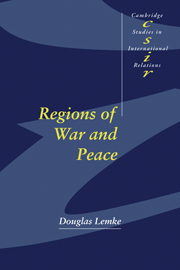Book contents
- Frontmatter
- Contents
- Acknowledgments
- 1 Introduction
- 2 Theoretical origins
- 3 Theoretical revision: the multiple hierarchy model
- 4 Identifying local hierarchies and measuring key variables
- 5 Empirical investigations
- 6 Further investigations I: great power interference?
- 7 Further investigations II: an African (interstate) Peace?
- 8 Conclusions, implications and directions for continued research
- Appendix: Replication with Correlates of War capabilities data
- References
- Index
- CAMBRIDGE STUDIES IN INTERNATIONAL RELATIONS
7 - Further investigations II: an African (interstate) Peace?
Published online by Cambridge University Press: 22 September 2009
- Frontmatter
- Contents
- Acknowledgments
- 1 Introduction
- 2 Theoretical origins
- 3 Theoretical revision: the multiple hierarchy model
- 4 Identifying local hierarchies and measuring key variables
- 5 Empirical investigations
- 6 Further investigations I: great power interference?
- 7 Further investigations II: an African (interstate) Peace?
- 8 Conclusions, implications and directions for continued research
- Appendix: Replication with Correlates of War capabilities data
- References
- Index
- CAMBRIDGE STUDIES IN INTERNATIONAL RELATIONS
Summary
In the analyses reported in the previous chapter, the Africa and South America dummy variables are always statistically significant. The statistical interpretation is Africa and South America are persistently different from the other regions in terms of war-fighting. I “know” these regions vary from other regions, but I have no idea why. I am specifically ignorant about the sources of cross-regional variation.
A consequence of estimating statistically significant region-specific coefficients is I can switch the regional dummies on and off and calculate how large an effect parity and dissatisfaction have on the probability of war within each specific region. When I do this I find a diminishing impact, substantively, of parity and dissatisfaction as I move from analysis of the Great Powers, through analysis of the Far East and Middle East, to analysis of South America and Africa. The diminishing impact and negative sign of the region-specific coefficients suggests an increasing pacificity. Regardless of whether parity and dissatisfaction are present, war is less likely in some regions than others. Since Africa's coefficient is the most negative, and since the corresponding substantive effect of parity and dissatisfaction on the probability of war is the smallest, we might conclude from this that Africa is the most peaceful region.
The notion of an African Peace is not intuitively appealing. News coverage of atrocities in Rwanda, of seemingly constant strife in the Horn of Africa, and within Congo/Zaire in the late 1990s, presents an image of a Hobbesian world, of the “war of all against all” (see Kaplan 1994, and Economist 2000a, 2000b).
- Type
- Chapter
- Information
- Regions of War and Peace , pp. 161 - 194Publisher: Cambridge University PressPrint publication year: 2002



